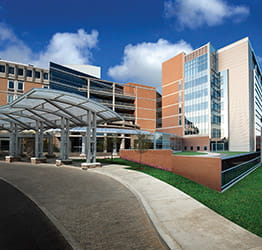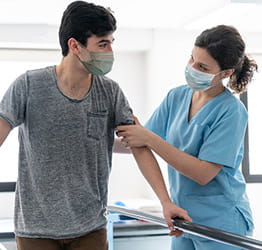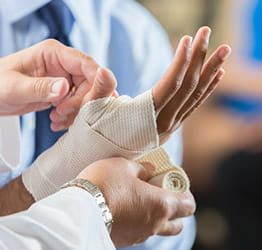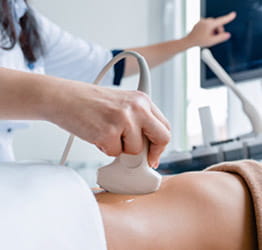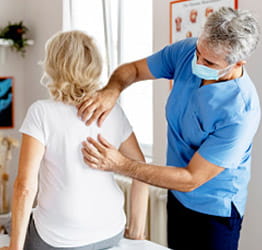Your lymphatic system is part of your body’s immune system. It helps protect you from infection and regulates fluid levels throughout your body.
Lymphedema is a condition that occurs when a problem with your lymphatic system causes fluid to accumulate in the space between your body’s cells, resulting in swelling (edema) that usually affects your arms or legs. Lymphedema can be present at birth, or it can occur after the removal of, or damage to, lymph nodes during cancer treatment.
UPMC experts offer comprehensive treatment for lymphedema, including physical therapy, compression, wound care, and more. Our team will work with you to develop a personalized treatment plan that improves your quality of life.
On this page
What Is Lymphedema?
Your lymphatic system is part of your body’s immune system. It helps protect you from infection and regulates fluid levels throughout your body.
Lymphedema is a condition that occurs when a problem with your lymph system causes fluid to accumulate in the space between your body’s cells, resulting in edema (swelling) that usually affects your arms or legs. Lymphedema can be present at birth or occur after the removal of, or damage to, lymph nodes.
What are the types of lymphedema?
There are two types of lymphedema:
- Primary lymphedema — Caused by rare, inherited conditions that affect how your lymphatic system develops, including Milroy’s disease, Meige disease, and lymphedema tarda.
- Secondary lymphedema — The most common type of lymphedema, secondary lymphedema is caused by damage to the lymphatic system resulting from surgery, trauma, or radiation therapy. It commonly occurs after breast cancer treatment.
What are the stages of lymphedema?
Stages of lymphedema include:
- Stage 0 — No visible swelling, but the affected area may feel swollen, tight, or heavy.
- Stage I — Occasional visible swelling that goes away with rest and elevation.
- Stage II — Near-constant visible swelling, with skin that feels firmer than surrounding skin.
- Stage III — Significant swelling with changes to skin color and texture.
How common is lymphedema?
Secondary lymphedema is common, affecting about one out of 1,000 people in the U.S. It most commonly occurs after breast cancer treatment.
Primary lymphedema is rare, affecting one in 100,000 individuals in the U.S.
What causes lymphedema?
Lymphedema can be caused by:
Can breast cancer cause lymphedema?
Breast cancer itself doesn’t cause lymphedema. However, breast cancer treatment can sometimes involve removing lymph nodes, which can cause lymphedema to develop.
What are lymphedema risk factors and complications?
Lymphedema risk factors
You may be at an increased risk of developing lymphedema if you have:
- An infection that damages your lymph system.
- Blood vessel conditions.
- Breast cancer surgery that involves removing lymph nodes.
- Obesity, which reduces the flow of lymph fluid.
- Trauma or injury to your lymphatic system.
Complications of lymphedema
Lymphedema may cause complications including:
- Deep vein thrombosis (DVT), which occurs when a blood clot forms in a leg vein.
- Emotional distress and problems with self-esteem due to visible swelling.
- Infection, such as cellulitis or lymphangitis.
- Lymphangiosarcoma, a rare soft tissue cancer caused by untreated lymphedema.
- Skin problems, such as fissures, ulcers, or papillomatosis.
How can I prevent lymphedema?
You may not be able to completely prevent lymphedema.
However, there are things you can do to reduce your risk, including:
- Ask your doctor about exercises you can do after breast cancer surgery to reduce the risk of swelling.
- Avoid extreme heat.
- Elevate the affected area.
- Exercise regularly.
- Wear loose-fitting clothing, unless your doctor recommends compression garments as part of your treatment plan.
Back to top
What Are the Signs and Symptoms of Lymphedema?
Symptoms of lymphedema may include:
- Feelings of burning or itching.
- Heaviness or tightness in your arms or legs.
- Limited range of motion due to swelling.
- Red, puffy skin.
- Swelling in your arms, feet, and/or legs.
- Thickening skin.
- Ulcers or sores on the legs, in advanced stages.
Lymphedema symptoms can be similar to those caused by other vascular conditions, including:
When should I see a doctor about my lymphedema symptoms?
If you have symptoms of lymphedema, schedule an appointment with your doctor right away. Getting early treatment can reduce your risk of complications and improve your quality of life.
Back to top
How Do You Diagnose Lymphedema?
To diagnose lymphedema, your doctor will ask about your symptoms, perform a physical exam, and order imaging tests.
What to expect during your visit
If your doctor suspects lymphedema, they will:
- Ask about your symptoms.
- Perform a physical exam.
- Order imaging tests.
- Review your health history and medications.
Tests to diagnose lymphedema
Imaging tests to diagnose lymphedema may include:
- CT scan — A painless, noninvasive test that uses x-ray technology to capture multiple cross-sectional images of organs, bones, and tissues inside your body.
- Magnetic resonance imaging (MRI) — A safe, noninvasive imaging test that uses a magnetic field and radio waves to produce highly detailed images of the inside of your body without radiation exposure.
- Ultrasound (sonography) — A painless, noninvasive test that uses high-frequency sound waves to produce real-time images of blood flow.
Lymphedema prognosis
Lymphedema is a chronic condition that can’t be cured, but symptoms can be managed with treatment and lifestyle changes.
What is the life expectancy of someone with lymphedema?
With treatment, lymphedema typically does not reduce life expectancy.
Back to top
How Do You Treat Lymphedema?
The goals of lymphedema treatment are to reduce symptoms and improve quality of life.
Treatment may include:
Lifestyle changes
Your doctor may recommend lifestyle changes, including:
- Avoiding extreme heat.
- Elevation.
- Exercise.
- Taking breaks from sitting to move around.
- Wearing loose-fitting clothing for comfort.
- Weight loss.
Physical therapy
Physical therapists with advanced training in lymphedema care may recommend treatments including:
- Compression therapy — Wearing bandages, specialized garments, or pump devices that provide pressure to prevent fluid accumulation and swelling.
- Manual lymphatic drainage (MLD) — A form of gentle massage that can be performed by a physical therapist or on your own.
Surgery for lymphedema
If nonsurgical treatments haven’t helped your severe lymphedema symptoms, your doctor may recommend surgical procedures, including:
- Debulking — A procedure for very severe lymphedema, debulking involves removing skin, fat, and tissue and covering the area with a skin graft.
- Lymphatic bypass procedure — Reroutes lymphatic veins and vessels to improve lymphatic drainage.
- Lymph node transfer — Uses healthy lymph nodes taken from another area of your body to replace damaged lymph nodes.
Back to top
Why Choose UPMC for Lymphedema Care?
When you choose UPMC for lymphedema care, you will receive:
- Comprehensive breast cancer expertise — The breast cancer experts at UPMC provide state-of-the-art care for every form of breast cancer at every stage of the disease.
- Management of treatment side effects — Our experts collaborate to help you manage the side effects of your treatment, including lymphedema.
- Supportive services tailored to your needs — Our approach to breast cancer care honors your preferences with supportive services for the best possible results.
Back to top
By UPMC Editorial Staff. Last reviewed on 2025-09-18.





